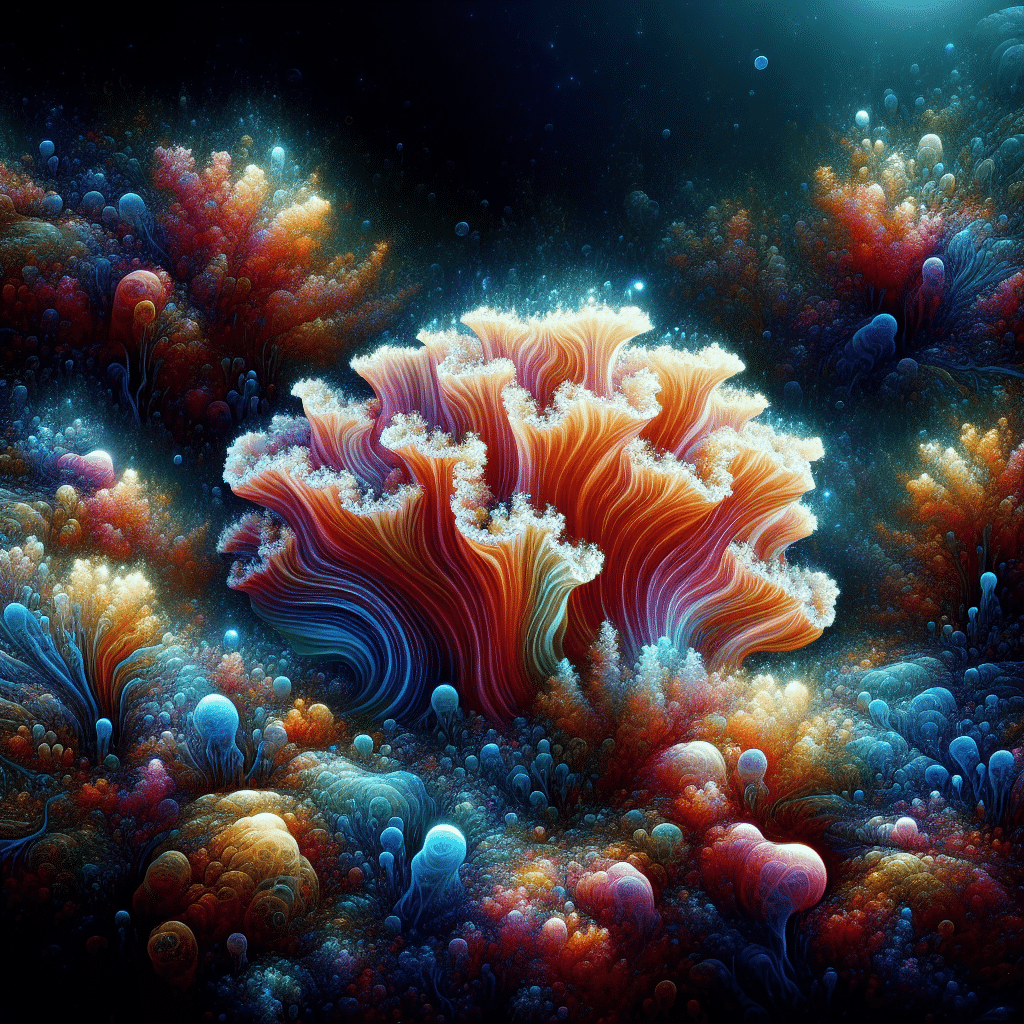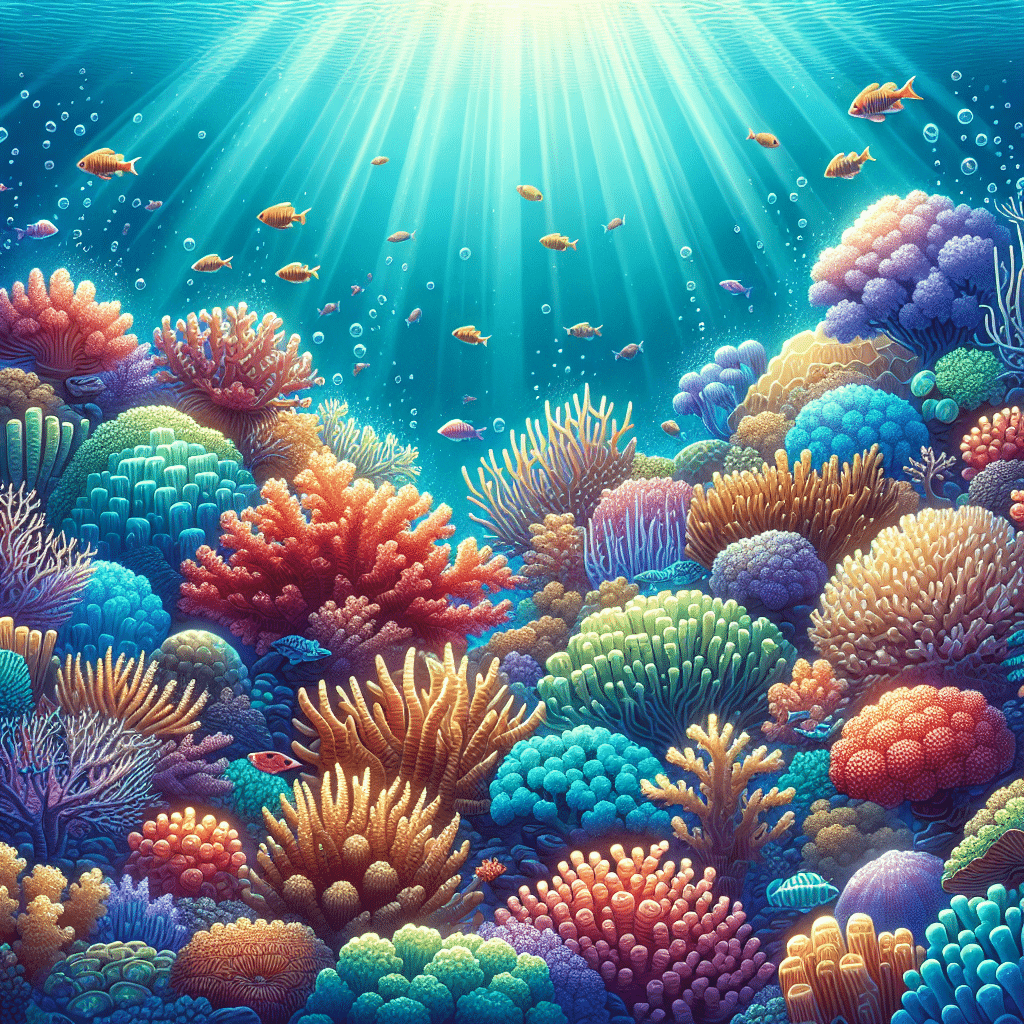Exploring Chalice Corals
Chalice corals are some of the most stunning additions to any reef tank. I love their vibrant colors and unique patterns, which can really make a tank pop.
Vibrant Colors and Patterns
Chalice corals are renowned for their vibrant and often fluorescent colors, which can vary significantly based on genetics and environmental factors (Abyss Aquatics). The Echinophyllia chalices, in particular, showcase some of the most colorful patterns in the chalice family. These corals typically develop intricate designs that can include multi-colored eyes and extravagant colored rims, like the TSA Pink Watermelon Chalice and the TSA Space Invader Chalice, which is truly mesmerizing.
| Color Variations | Notable Examples |
|---|---|
| Fluorescent Yellow | TSA Space Invader Chalice |
| Bright Pink | TSA Pink Watermelon Chalice |
| Deep Purple | Afterburner Chalice |
| Multi-colored | Echinophyllia Chalices |
Chalices generally encrust over the surrounding rock and can plate around their base, creating a captivating display in any aquarium setting. Their unique color combinations are part of what makes them so desirable for hobbyists.
Family and Habitat
Chalice corals belong to the family Pectiniidae, which encompasses a wide range of corals from about ten different genera, including Lithophyllon, Oxypora, Echinopora, and Mycedium. These corals are typically found in shallow waters of the Indo-Pacific region, thriving on reef slopes and in lagoons where they can receive adequate light and water flow.
Due to their sensitivity to environmental fluctuations, chalice corals are not the most resilient choice for beginner aquarists. They are better suited for those who have gained some experience in keeping corals and have established a stable environment in their tanks. I recommend introducing chalice corals after a few months of setting up your reef tank, allowing time for the ecosystem to stabilize.
If you’re looking to explore more about different types of corals, you can check out our pages on brain coral, mushroom coral, and acropora to expand your knowledge.
Care and Maintenance
Suitable for Intermediate Aquarists
Chalice corals are best suited for intermediate aquarists. They require stable aquarium conditions and are not the most resilient to changes in water parameters. I learned that it’s essential to have a well-established tank before introducing chalice corals. They are sensitive to fluctuations, which can lead to stress or even death. Additionally, these corals can be aggressive towards other species, including their own kind, so providing adequate spacing is crucial (Abyss Aquatics).
| Consideration | Recommendation |
|---|---|
| Tank Stability | Established tank (at least 6 months) |
| Water Quality | Stable parameters (salinity, pH) |
| Coral Aggression | Keep a safe distance from other corals |
Feeding and Aggression
Feeding chalice corals can enhance their health and vibrancy. I’ve found that they benefit from supplemental feeding with meaty foods like brine shrimp, mysis shrimp, and plankton. Chalice corals can trap food on their mucus membranes and use their sweeper tentacles for defense and to capture prey. However, it’s important to be aware of their aggressive nature. They can release long tentacles that sting and kill surrounding corals, making it essential to carefully position them in the tank to avoid conflicts (Light Fish).
| Food Source | Frequency |
|---|---|
| Brine Shrimp | 2-3 times a week |
| Mysis Shrimp | 2-3 times a week |
| Plankton | Weekly |
In summary, when caring for chalice corals, prioritize stable water conditions, adequate spacing, and appropriate feeding practices. Their aggressive tendencies and specific care requirements make them a satisfying yet challenging addition to any reef tank. For more information on other coral types, check out our guides on brain coral and mushroom coral.
Popular Chalice Varieties
When it comes to chalice coral, there are some truly stunning varieties that stand out in the reef tank. Two of my favorites are the Afterburner Chalice and the TSA Pink Watermelon Chalice. Each of these has its own unique characteristics and care requirements, making them popular choices among hobbyists.
Afterburner Chalice
The Afterburner Chalice is known for its vibrant and fiery coloration. It typically features a bright orange or red base with contrasting green or blue highlights, creating a truly eye-catching display in any tank. This coral thrives in low to medium lighting conditions, making it suitable for various setups.
| Feature | Detail |
|---|---|
| Color | Bright orange/red with green/blue |
| Lighting Preference | Low to medium |
| Flow Requirements | Low to medium |
| Aggressiveness | High, can sting nearby corals |
Keep in mind that the Afterburner Chalice can be aggressive towards other corals, so I make sure to provide it with enough space to prevent it from stinging its neighbors. I position it away from other corals and ensure it has the right flow direction to avoid any mishaps.
TSA Pink Watermelon Chalice
The TSA Pink Watermelon Chalice is another stunning variety that stands out with its unique patterns and colors. This coral typically showcases a pink base with green and yellow accents, resembling the look of a watermelon. Its vibrant colors make it a favorite among reef enthusiasts.
| Feature | Detail |
|---|---|
| Color | Pink with green/yellow accents |
| Lighting Preference | Medium |
| Flow Requirements | Low to medium |
| Aggressiveness | Moderate, can sting nearby corals |
This chalice also prefers low to medium flow and can adapt well to various lighting conditions. As with the Afterburner Chalice, I ensure proper spacing to prevent aggressive interactions with other corals. I love watching this coral thrive and grow in my tank, adding a splash of color and uniqueness.
Both chalice corals require careful consideration regarding their placement and care. If you’re looking to add some vibrant beauty to your reef tank, these varieties are definitely worth considering. For more on coral types, check out our sections on brain coral and mushroom coral to expand your knowledge of the diverse options available.
Environmental Factors
Understanding the environmental needs of chalice coral is essential for their thriving in a reef tank. I’ve learned that both lighting preferences and water flow requirements play a significant role in their health and appearance.
Lighting Preferences
Chalice corals thrive under specific lighting conditions. They prefer low to moderate lighting, generally ranging from 80-200 PAR. I’ve found that they display their best colors under a blue light spectrum, which enhances their vibrant hues. If the lighting is too intense, chalices will quickly show their distress by compressing their tissue against their skeleton. Here’s a quick summary of their lighting preferences:
| Lighting Condition | PAR Range | Notes |
|---|---|---|
| Low Light | 80-100 | Best for most chalice varieties |
| Moderate Light | 100-200 | Some chalices may do well here |
| Intense Light | Over 200 | Can lead to bleaching |
For optimal results, placing chalice corals towards the bottom of the tank in slightly shaded areas is recommended. They look outstanding under actinic bulbs, and avoiding strong lighting is key to maintaining their health (Top Shelf Aquatics, Light Fish, Sunnyside Corals).
Water Flow Requirements
Water flow is another crucial factor for chalice coral care. They thrive in low to moderate water flow, which helps prevent debris from accumulating on their delicate tissues. I’ve discovered that strong water flow can be detrimental, as it may cause stress to the coral.
| Flow Condition | Description |
|---|---|
| Low Flow | Ideal for most chalices; prevents debris buildup |
| Moderate Flow | Suitable for some varieties; must be monitored to avoid stress |
It’s essential to consider the direction of the flow as well. When chalices release their stingers, the flow can carry them toward nearby corals, potentially causing harm. Taking care to position chalice corals in areas with gentle currents can help avoid aggressive interactions with neighboring corals. Some chalices, like the Hollywood stunner, may even develop sweeper tentacles, so awareness of their placement is crucial (Top Shelf Aquatics, Sunnyside Corals).
By understanding these environmental factors, I can create a thriving habitat for my chalice corals, ensuring they flourish in my reef tank.
Feeding and Growth
Food Sources
As a proud owner of chalice corals, I’ve learned that proper feeding is essential for their health and vibrant appearance. Chalice corals primarily rely on their zooxanthellae algae for energy, but they also benefit from supplemental feeding. I often provide them with meaty foods like brine shrimp, mysis shrimp, and plankton. These corals have a unique way of trapping food using their mucus membranes and possess sweeper tentacles to defend themselves (Abyss Aquatics).
For optimal growth, I recommend feeding them powdered coral foods and pellets such as Fauna Marin LPS Pellets and Benepets. It’s best to turn off the water flow during feedings, as chalices can take up to 15-20 minutes to consume their meals (Top Shelf Aquatics). Here’s a quick summary of the food sources I’ve found effective:
| Food Type | Benefits |
|---|---|
| Brine Shrimp | High in protein, encourages growth |
| Mysis Shrimp | Enhances coloration and vitality |
| Plankton | Provides essential nutrients |
| Powdered Coral Foods | Supports overall health |
| LPS Pellets | Ideal for easy feeding |
Growth Rate Insights
Chalice corals can grow quite large; in the wild, some colonies reach over 2 feet across. In my home reef aquarium, a chalice coral measuring one foot in length is considered large. It’s fascinating to observe how different types of chalice corals exhibit varying growth rates. Those with thin skeletons can double in size every four months, providing a stunning visual impact in a relatively short time. On the other hand, chalices with thicker skeletons grow at a slower pace, about ¼ inch per month (Light Fish).
Here’s a quick comparison of growth rates for chalice corals:
| Skeleton Type | Growth Rate |
|---|---|
| Thin | Doubling in size every 4 months |
| Thick | Approximately ¼ inch per month |
Feeding my chalice corals regularly and understanding their growth patterns has made my reef tank thrive. For more information on different types of corals, check out my articles on brain coral, mushroom coral, and montipora.
Coral Reproduction
Sexual and Asexual Reproduction
Chalice corals, like many other coral species, have the ability to reproduce both sexually and asexually. In sexual reproduction, chalice corals can spawn or brood, leading to the establishment of new coral colonies. This process typically occurs during specific times of the year when environmental conditions are optimal for reproduction.
On the other hand, asexual reproduction occurs through fragmentation or budding. Fragmentation involves a piece of the coral breaking off and growing into a new colony, while budding involves the formation of new polyps on the existing coral structure. Branching corals commonly reproduce this way, and chalice corals can also engage in this method, though they are primarily known for their aggressive nature towards other corals, including their own species (Florida Fish and Wildlife Conservation Commission).
Fragments and Budding
When it comes to chalice corals, fragmentation is a particularly important method of asexual reproduction. This allows for the expansion of existing colonies and the creation of new ones, contributing to the overall biodiversity of a reef tank. However, it’s essential to manage the placement of chalice corals carefully. Their aggressive nature, characterized by the use of long sweeper tentacles, can lead to conflicts with other corals in the tank. This means that ensuring enough space and proper positioning is crucial to avoid unwanted aggression (Light Fish).
Budding is another method through which chalice corals can grow. This process results in the formation of new polyps on the coral, allowing for a gradual increase in the colony size. Although chalice corals can reproduce in these ways, their resilience to environmental changes is limited, so it’s recommended to introduce them into a well-established tank after several months of setup (Sunnyside Corals).
Understanding these reproductive methods helps to appreciate how chalice corals contribute to their ecosystems and how to care for them in a reef tank setting. If you’re also interested in other types of corals, check out our articles on brain coral, mushroom coral, and montipora for more insights.
Coral Health and Diseases
Resilience to Fluctuations
Chalice corals, while stunning in appearance, are generally not the most resilient to changes in water conditions. This makes them less suitable as a first coral for new aquarists. I’ve found that these corals are best introduced after the tank has been established for a few months. More expensive varieties tend to be even more sensitive and have slower growth rates (Sunnyside Corals).
To maintain their health, it’s essential to keep a close eye on water parameters. Any significant fluctuations can lead to stress, which may cause these corals to close up or even result in death. Here’s a quick reference table for optimal water parameters for chalice coral:
| Parameter | Optimal Range |
|---|---|
| Temperature | 76-82°F (24-28°C) |
| pH | 8.1-8.4 |
| Salinity | 1.024-1.026 |
| Nitrate (NO3) | <10 ppm |
| Phosphate (PO4) | <0.05 ppm |
Disease Prevention Tips
Preventing diseases in chalice corals requires a proactive approach. Here are some tips I’ve found helpful:
Stable Environment: Ensure that water conditions are stable. Regular testing and maintenance can prevent sudden fluctuations that stress the coral.
Adequate Space: Chalice corals are known for their aggressive nature and can use their sweeper tentacles to attack nearby corals, including their own species (Light Fish). Position them carefully to avoid contact with other corals and provide ample space.
Correct Lighting and Flow: Position chalice corals in areas with appropriate lighting and flow conditions. They thrive with moderate light and flow, which helps them maintain their health and vibrant colors.
Regular Feeding: Providing proper nutrition can enhance their resilience. Feeding them with quality coral food can promote growth and overall health.
Watch for Signs of Stress: Keep an eye on your chalice coral for any signs of distress, such as closing up or discoloration. Early detection can help prevent larger issues down the line.
By taking these precautions, I’ve managed to keep my chalice corals thriving alongside other species like brain coral and mushroom coral. Regular attention to their needs will help ensure that they remain a vibrant part of my reef tank.
Chalice Coral Placement
Lighting and Flow Considerations
When it comes to placing chalice corals in my reef tank, lighting and water flow are two crucial factors to keep in mind. Chalice corals prefer low to medium light levels, ideally between 100-200 PAR. I find that they look particularly stunning under actinic bulbs, which can really enhance their vibrant colors. It’s important to avoid intense lighting as it can lead to bleaching, so I usually position my chalice corals towards the bottom of the tank in slightly shaded areas.
In terms of water flow, chalice corals do best with low to medium flow. The direction of the flow is essential since chalices release long tentacles that can sting and harm surrounding corals. I make sure to place them in a spot where the flow won’t blow their tentacles into other corals. This helps minimize aggression and ensures that each coral has enough space to thrive. For more insights on coral types, check out our article on corals.
| Lighting Type | Recommended PAR Level |
|---|---|
| Low to Medium Light | 100 – 200 PAR |
Tank Stability and Acclimatization
Chalice corals are not the most resilient to fluctuations in water parameters, which is why I recommend introducing them after my tank has been established for a few months. They are more sensitive than some other coral types, and I’ve learned that the more expensive chalices tend to be even touchier. It’s vital to maintain stable conditions for these corals. I usually monitor my tank closely during the acclimatization period, ensuring that the temperature, salinity, and water quality remain consistent.
Acclimatization is key when introducing chalice corals to my tank. I prefer to use the drip method to gradually adjust them to my tank’s conditions. This helps reduce stress and allows the corals to adapt more comfortably. Following the recommended practices can prevent complications and promote healthier growth. If you’re curious about other coral varieties, consider looking into brain coral or mushroom coral.
By paying attention to these placement factors, I can ensure that my chalice corals thrive and add beauty to my reef tank.



